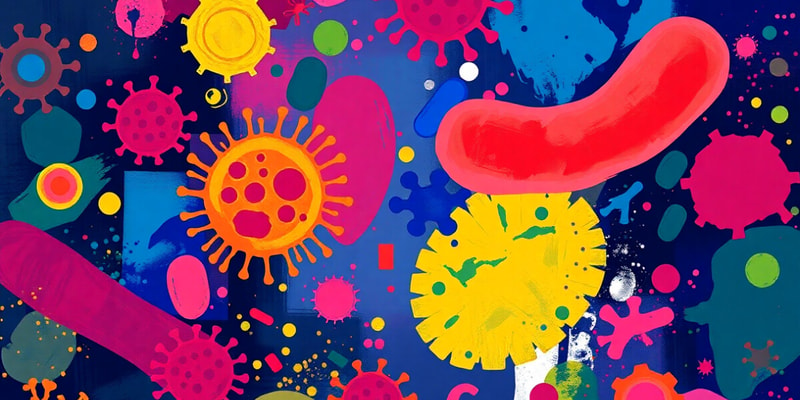Podcast Beta
Questions and Answers
What condition does Zolgensma treat?
How does Luxturna function in treating vision loss?
What is the primary use of PCR (Polymerase Chain Reaction)?
Which gene therapy introduces a working copy of the SMN1 gene?
Signup and view all the answers
What is the function of Zynteglo in treating beta-thalassemia?
Signup and view all the answers
What condition can Next-Generation Sequencing (NGS) help diagnose?
Signup and view all the answers
What type of assay is ELISA primarily used for?
Signup and view all the answers
Which gene therapy is indicated for patients needing blood transfusions due to beta-thalassemia?
Signup and view all the answers
What is the goal of personalized medicine?
Signup and view all the answers
Which therapy utilizes advanced gene therapy techniques to address genetic diseases?
Signup and view all the answers
What innovative approach has improved vaccine development during pandemics?
Signup and view all the answers
How does regenerative medicine aim to address organ donor shortages?
Signup and view all the answers
What is an example of an advanced diagnostic tool for early disease detection?
Signup and view all the answers
Which therapy exemplifies improved cancer treatments through targeted approaches?
Signup and view all the answers
What does biomanufacturing enhance in the production of biopharmaceuticals?
Signup and view all the answers
What is a key benefit of improved cancer treatments like immunotherapy?
Signup and view all the answers
What is the primary function of CRISPR-based diagnostics in detecting pathogens?
Signup and view all the answers
Which application of microarray technology helps personalize medicine?
Signup and view all the answers
What do biosensors primarily detect in their applications?
Signup and view all the answers
Which technique utilizes antibodies to visualize specific proteins in tissue samples?
Signup and view all the answers
What is the main purpose of mass spectrometry in biological research?
Signup and view all the answers
Which application is specifically associated with flow cytometry?
Signup and view all the answers
Metabolomics is primarily concerned with analyzing what?
Signup and view all the answers
Which of the following is NOT an application of CRISPR technology?
Signup and view all the answers
What is one potential benefit of genetically modified crops?
Signup and view all the answers
Which biotechnology method is used for cleaning up polluted environments?
Signup and view all the answers
What is a purpose of biofortification in food biotechnology?
Signup and view all the answers
What is a characteristic of animal biotechnology?
Signup and view all the answers
Which application of biotechnology specifically targets the production of chemicals from renewable resources?
Signup and view all the answers
What advantage does biotechnology have over traditional chemical synthesis?
Signup and view all the answers
What is a key benefit of using probiotics in food biotechnology?
Signup and view all the answers
What does bioinformatics contribute to biological research?
Signup and view all the answers
What is the primary benefit of biotechnological advancements in penicillin production?
Signup and view all the answers
Which antibiotic is specifically noted for its effectiveness against MRSA?
Signup and view all the answers
How does biotechnology enhance the production process of aminoglycoside antibiotics?
Signup and view all the answers
Which bacterium is the source of the antibiotic gentamicin?
Signup and view all the answers
What is a use of lipopeptide antibiotics such as daptomycin?
Signup and view all the answers
What condition is Luxturna designed to treat?
Signup and view all the answers
Which of the following antibiotics has been engineered to combat a broader range of bacteria?
Signup and view all the answers
What advances have been made in the production of glycopeptide antibiotics?
Signup and view all the answers
Study Notes
Antibiotic Production
-
Penicillin
- Originally derived from Penicillium mold
- Biotechnology has improved fermentation and engineered strains for increased yield
- Semi-synthetic derivatives (amoxicillin and cephalosporins) created for broader bacterial coverage
-
Glycopeptide Antibiotics (e.g. Vancomycin)
- Critical for serious Gram-positive bacterial infections, including MRSA
- Biotechnology enhances production methods to meet growing demand
-
Aminoglycoside Antibiotics (e.g. Gentamicin)
- Produced by Micromonospora purpurea
- Effective against various bacterial infections
- Biotechnology optimizes fermentation for yield and purity
-
Lipopeptide Antibiotics (e.g. Daptomycin)
- Derived from Streptomyces roseosporus
- Treats skin infections and bacteremia
- Biotechnology enables large-scale production
Gene Therapy Applications
-
Luxturna (Voretigene Neparvovec)
- Treats inherited retinal dystrophy (RPE65 gene mutations)
- Delivers a functional RPE65 gene to restore vision or slow vision loss
- Approved by FDA in 2017
-
Zolgensma (Onasemnogene Abeparvovec)
- Treats spinal muscular atrophy (SMA)
- Introduces a working SMN1 gene to replace the faulty gene
- Enables normal SMN protein production, crucial for motor neuron survival
- Approved by FDA in 2019
-
Zynteglo (Betibeglogene Autotemcel)
- Treats beta-thalassemia, a blood disorder affecting hemoglobin production
- Adds functional HBB gene copies to hematopoietic stem cells
- Enables sufficient hemoglobin production, reducing transfusion needs
- Approved by EMA in 2019 and FDA in 2022
Diagnostic Technologies
-
PCR (Polymerase Chain Reaction):
- Amplifies specific DNA sequences for detection of trace genetic material
- Used in COVID-19 testing for viral RNA detection
- Identifies genetic mutations in diseases like cystic fibrosis and cancer
- Detects pathogens like HIV, hepatitis, and tuberculosis
-
ELISA (Enzyme-Linked Immunosorbent Assay):
- Uses antibodies and color change to detect specific proteins or antibodies in a sample
- Detects HIV antibodies
- Measures hormones like insulin or thyroid hormones
- Identifies allergen-specific IgE antibodies
-
Next-Generation Sequencing (NGS):
- Sequences large amounts of DNA for comprehensive genomic analysis
- Detects mutations in multiple cancer-related genes
- Identifies genetic abnormalities (e.g., Down syndrome) in prenatal screening
- Diagnoses rare inherited disorders
-
CRISPR-Based Diagnostics:
- Utilizes guide RNA to target and cleave DNA/RNA from pathogens or mutated genes
- Rapid COVID-19 test systems like SHERLOCK detect SARS-CoV-2 virus
- Potential for point-of-care diagnosis of infectious diseases
-
Microarray Technology:
- Hybridizes sample DNA to probes on a chip to detect gene expression
- Identifies gene expression changes in tumor cells (cancer gene profiling)
- Assesses genetic variants affecting drug metabolism (pharmacogenomics)
-
Biosensors:
- Combine biological elements (enzymes, antibodies) and physical transducers to detect molecules
- Monitor blood glucose levels in diabetic patients
- Enable rapid point-of-care tests for infections
-
Immunohistochemistry (IHC):
- Uses antibodies to detect specific proteins in tissue sections
- Detects biomarkers like HER2 in breast cancer
- Identifies autoantibodies in autoimmune diseases
-
Mass Spectrometry:
- Measures molecular mass for protein identification and quantification
- Identifies protein biomarkers in proteomics
- Detects metabolites or contaminants in drug testing
-
Flow Cytometry:
- Measures physical and chemical characteristics of cells in a fluid stream using lasers
- Diagnoses leukemia and lymphoma by detecting abnormal cell populations
- Monitors HIV patients by measuring CD4+ T cell levels
-
Metabolomics:
- Analyzes small molecules (metabolites) in biological systems to understand metabolic pathways
- Detects metabolite biomarkers in cancer and diabetes diagnosis
- Monitors metabolic response to therapies or diets
- Tailors treatment based on individual metabolic profiles (personalized medicine)
Benefits of Biotechnology
-
Unique Product Production:
- Enables production of complex biological molecules (e.g., insulin) that are challenging to synthesize chemically
-
High Selectivity and Targeting:
- Yields highly specific products, reducing unwanted by-products
-
Reduced By-products:
- Creates cleaner processes with less waste compared to traditional chemical synthesis
-
Mild Reactor Conditions:
- Operates under moderate conditions, promoting energy efficiency and safety
Studying That Suits You
Use AI to generate personalized quizzes and flashcards to suit your learning preferences.
Related Documents
Description
This quiz covers key aspects of antibiotic production, including various classes of antibiotics like penicillin, glycopeptides, aminoglycosides, and lipopeptides. It also discusses advancements in biotechnology that enhance antibiotic yield and purity, alongside an overview of gene therapy applications such as Luxturna. Test your knowledge on these critical topics in modern medicine.




